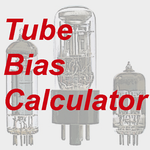
The Tube Bias Calculator will calculate power tube bias dissipation and % max.
advertisement
| Name | Tube Bias Calculator |
|---|---|
| Version | 2.8 |
| Update | Oct 06, 2024 |
| Size | 4 MB |
| Category | Music & Audio |
| Installs | 5K+ |
| Developer | Rob Robinette |
| Android OS | Android 2.1+ |
| Google Play ID | appinventor.ai_robinette77.TubeBiasCalculator |
Tube Bias Calculator · Description
The Tube Bias Calculator will calculate power tube bias values of Plate Current, Dissipation and % of Max Dissipation using either measured voltage drop across a cathode resistor or measured plate current. It has a database of 36 tube types and will calculate the Class A Fixed, Class AB Fixed Bias and Cathode Bias Maximum Safe Bias settings.
To calculate the tube's Max Safe Bias setting you simply pick your tube from the pick list and enter the Plate-to-Cathode Voltage (plate voltage is always measured between the tube's plate and cathode). The Maximum Safe Bias settings for Class A Fixed, Class AB Fixed Bias and Cathode Bias are displayed.
To calculate bias when you measure the plate current, such as when using the output transformer shunt current measurement, enter your Tube Type and Plate-to-Cathode voltage at the top of the page, enter the Plate Current and touch 'Calculate' and the Plate Dissipation and Dissipation% are shown.
To calculate bias by measuring the voltage drop across a cathode resistor enter your Tube Type and Plate-to-Cathode voltage at the top of the page, enter the Number of Tubes that share the cathode resistor, the Voltage Drop Across the Cathode Resistor and the Cathode Resistor actual resistance. Touch 'Calculate' and the Total Cathode Current, Total Plate Current, Plate Dissipation, Plate Dissipation % & Current per Tube are shown.
To measure the voltage drop across a resistor set your multimeter to volts DC and touch each leg of the resistor with a probe (disregard any minus sign).
WARNING: Amplifiers have high voltage that can KILL even when unplugged. Do not attempt to set an amplifier's bias unless you are competent with test gear and very familiar with high voltage and the dangers involved.
To calculate the tube's Max Safe Bias setting you simply pick your tube from the pick list and enter the Plate-to-Cathode Voltage (plate voltage is always measured between the tube's plate and cathode). The Maximum Safe Bias settings for Class A Fixed, Class AB Fixed Bias and Cathode Bias are displayed.
To calculate bias when you measure the plate current, such as when using the output transformer shunt current measurement, enter your Tube Type and Plate-to-Cathode voltage at the top of the page, enter the Plate Current and touch 'Calculate' and the Plate Dissipation and Dissipation% are shown.
To calculate bias by measuring the voltage drop across a cathode resistor enter your Tube Type and Plate-to-Cathode voltage at the top of the page, enter the Number of Tubes that share the cathode resistor, the Voltage Drop Across the Cathode Resistor and the Cathode Resistor actual resistance. Touch 'Calculate' and the Total Cathode Current, Total Plate Current, Plate Dissipation, Plate Dissipation % & Current per Tube are shown.
To measure the voltage drop across a resistor set your multimeter to volts DC and touch each leg of the resistor with a probe (disregard any minus sign).
WARNING: Amplifiers have high voltage that can KILL even when unplugged. Do not attempt to set an amplifier's bias unless you are competent with test gear and very familiar with high voltage and the dangers involved.










